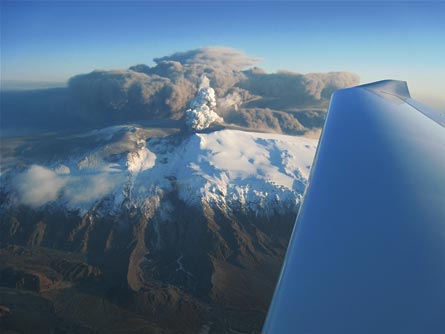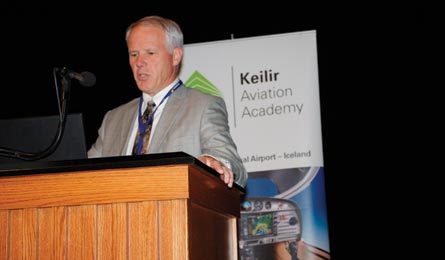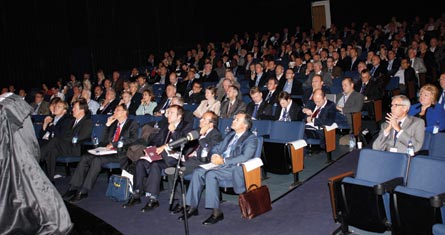European air transport need not have been immobilised by the Eyjafjallajökull volcanic eruptions in April, a review of the situation by a multidisciplinary expert group has concluded. But the group also agreed that Europe's airspace faces a high risk of contamination again from an Icelandic volcano in the coming decades, and that scientific understanding of the risk to aircraft of volcanic ash is incomplete and needs urgently to be advanced.
Speaking at last month's Conference on Eyjafjallajökull and Aviation at the Keilir Aviation Academy, Keflavik, Iceland, volcanologist Dr Haraldur Sigurdsson warned that this massively expensive disruption will not be the last time Europe will be exposed to atmospheric volcanic ash. The Eyjafjallajökull eruption was minuscule on a historic scale, he explained, and more powerful events are just a matter of time.
|
|---|
It became clear during the conference that existing knowledge, properly employed, could have substantially reduced the massive losses that airlines and the European economy suffered as a result of the grounding, ordered by national aviation authorities.
The International Air Transport Association's director for safety and operations Gunther Matschnigg described Europe's April reaction to Eyjafjallajökull as "risk aversion, not risk management". He advised learning from the standard operating procedures adopted successfully by airlines that have operated for years through airspace where atmospheric ash is a fairly regular hazard.
The trouble was that, at the time, the knowledge did not exist in Europe, except at British Airways and some of the other major intercontinental operators. Some months after the disruption BA revealed to Flightglobal that its standard operating procedure was to fly at least 185km (100nm) away from any volcano's visible ash plume, and that this had proven completely safe over the years. But BA was unable to provide figures as to how often it had done this, nor cite the density of any residual ash through which its aircraft had flown without damage.
Airbus's senior flight test engineer Manfred Birnfeld, commenting on the company's probing flights during the ash contamination period in April, told the conference: "Ash probing is meaningful only together with precise measurement of what is encountered." He said that Airbus is ready to put its flight-test expertise at the disposal of international bodies devoted to advancing knowledge of dealing with volcanic ash, but specialist tasks like ash concentration and quality measurement should be conducted by appropriate scientific bodies working with Airbus.
So Europe's national aviation authorities were not familiar with the phenomenon and how to manage its risks. Neither were the European Commission, Eurocontrol or the European Aviation Safety Agency. Now, even with the benefit of hindsight, the week-long disruption looks to have been inevitable. Europe had not anticipated a major ash event in any of its planning. For that reason none of the EU countries, individually or collectively, had availed themselves of the lessons from the ash experience that US airlines had built up through operating close to volcanic activity in Alaska. At that point, the world as a whole, using the International Civil Aviation Organisation as its forum, had formally concludedthat ash clouds could always be circumnavigated, so there was no need to develop detailed guidance for what to do if that were impossible.
|
|---|
NO-FLY ZONE
Head of the UK Civil Aviation Authority's airworthiness division Padhraic Kelleher described what the CAA knew at the time, and why decision-making was difficult: "Immediately after the 14 April eruption, the London VAAC [volcanic ash advisory centre] published the contours required by ICAO around airspace in which ash concentration was predicted [to be] 2x10-4g/m3 or more." According to that ICAO advice, explained Kelleher, that area became a no-fly zone. He commented: "The economic consequences were obvious. But what were the safety effects for aircraft exposed to this level of ash? Could they safely tolerate higher levels? We did not know." They learned quickly, Kelleher told the conference: "Over the next few days, a lot of people, many of them here today, worked day and night to find answers. Finally, the manufacturers could confirm that their aircraft and engines would tolerate exposure to ash at 10 times that concentration." Airbus's Birnfeld, describing the airframe manufacturer's part in the European decision-making process, explained that at that time, for lack of any other leadership, "the UK CAA led the immediate crisis management activity aimed at providing relief for European Union traffic".
The incentive to prevent a repeat is certainly there. Speaking at Keflavik, the European Commission's director of air transport Daniel Calleja-Crespo revealed the magnitude of the damage to Europe's economy. Airline direct losses were €1.7 billion ($2.3 billion), the result of being forced to cancel 100,000 flights with the loss of 10 million passenger journeys. Meanwhile 313 European airports were totally immobilised, and as a result suffered a €317 million loss of revenue.
The indirect or secondary losses were even larger. Stephen Perkins, head of the joint transport research centre for the International Transport Federation at the Organisation for Economic Cooperation and Development, estimates the added value to the European economy of the aviation industry and its infrastructure at $1.1 trillion a year, and that vital industry was immobilised for a week. Perkins put the Eyjafjallajökull losses to airlines, the hospitality industry and stranded workers, in terms of their normal contribution to Europe's gross domestic product, at $5 billion.
Calleja-Crespo spelled out the options available for dealing with future ash events. These, he said, are to maintain the status quo; to improve the quality of information and data supplied to airlines and to leave the responsibility for go/no-go decisions to them; or to redefine atmospheric ash density risks and impose no-go zoning decisions on the airlines.
One of the most catastrophic European weaknesses that Eyjafjallajökull brought to light - the lack of co-ordination between the national aviation authorities - is less likely to happen next time, because of the creation since then of a European Aviation Crisis Coordination Cell. For volcanic events specifically, Calleja-Crespo says Europe will also develop a new methodology for risk assessment and risk management, taking stock of current technologies and methodologies.
The director of ICAO's Air Navigation Bureau Nancy Graham told the conference that a new body, the International Volcanic Ash Task Force, would address the need for global co-ordination of the gathering and dissemination of additional scientific knowledge on volcanic ash as it relates to airworthiness, operations, air traffic management, and optimising the functioning of the existing VAACs and meteorological organisations.
Europe and the North Atlantic are now operating an interim "volcanic ash contingency plan" while improved data is researched. This consists of a three-zone area based on VAAC ash predictions. At the heart - basically where the visible plume is located - is a no-fly zone (NFZ). Surrounding that will be a time-limited zone (TLZ) based on predicted ash concentrations defined according to engine manufacturer advice, and outside that an enhanced procedures zone (EPZ). Aircraft flown through the EPZ have to follow manufacturer advice on additional inspections following use of that airspace. All the ash concentration values have been revised according to the manufacturer's advice described by the UK Civil Aviation Authority's Kelleher.
Decisions to go beyond the three-zone interim measures depend on improving the quality and accuracy of ash distribution information, and the understanding of airworthiness limitations, said Kelleher: "The way forward begins with recognition that each airline is responsible for assessing risk before operating, and the regulator's responsibility is to make sure that they are competent and capable of doing so."
|
|---|
ENGINE TOLERANCE
The senior vice-president technical services at Rolls-Royce Patrick Emmott said that the tolerance of modern jet engines to ash is 10 times that assumed by European agencies when Eyjafjallajökull erupted. He also said that the existing models for predicting the location of atmospheric ash need to be more accurate. Inspections of engines predicted to have been exposed to ash proved they had usually not been exposed at all, says Emmott. He warned that attempts to design engines to be more resistant to ash damage would inevitably result in increased fuel burn and emissions.
Capt Bob Graves, flight operations director at Alaska Airlines, provided a review of operations in an area frequently affected by volcanic ash. Far from becoming complacent through familiarity, Graves' description painted a picture of an airline fully aware of the risks, and with a comprehensive set of strict operating guidelines for flight and ground crews, plus the provision of regular training for pilots in ash encounter drills.
An extract from the company flight manual gives a flavour of this: "For night and/or instrument meteorological conditions, flights will be planned at least 35nm horizontally from known or forecast ash clouds. In the event of a major event we will continually evaluate and adjust any restrictions."
Southern Alaska and the Aleutian chain islands are peppered with active volcanoes, many monitored by remote cameras relaying real-time or time-delay pictures to the Alaska VAAC. The VAAC continually monitors ash cloud propagation and also operates predictive models for operations in IMC. Alaska Airlines works alongside the VAAC.
The conference chairman Dr Thorgeir Pálsson, professor of air navigation technology at Reykjavik University and former director general of the Icelandic Civil Aviation Administration and air navigation service provider ISAVIA, provided his verdict on the outcome, commenting: "There is a strong movement towards shifting to the operator the responsibility for deciding whether to fly and how to conduct the flight in the case of contamination of airspace by volcanic ash. This would be done in a strictly regulated environment where the risk assessment and management procedures of airlines would be scrutinized and approved by the appropriate aviation authority."
Source: Flight International





























